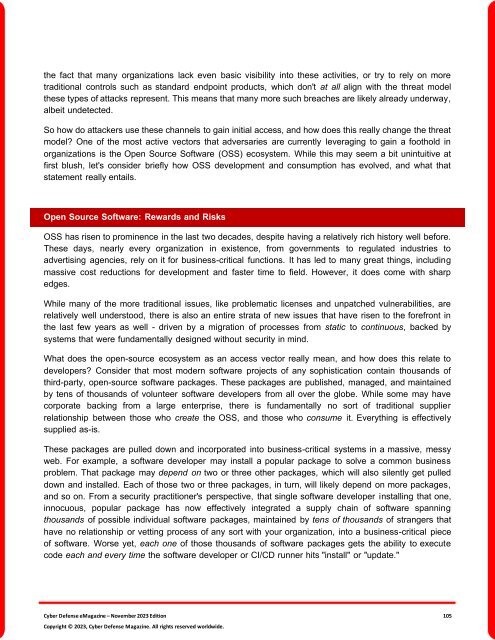The Cyber Defense eMagazine November Edition for 2023
Cyber Defense eMagazine November Edition for 2023 #CDM #CYBERDEFENSEMAG @CyberDefenseMag by @Miliefsky a world-renowned cyber security expert and the Publisher of Cyber Defense Magazine as part of the Cyber Defense Media Group as well as Yan Ross, Editor-in-Chief and many more writers, partners and supporters who make this an awesome publication! 196 page November Edition fully packed with some of our best content. Thank you all and to our readers! OSINT ROCKS! #CDM #CDMG #OSINT #CYBERSECURITY #INFOSEC #BEST #PRACTICES #TIPS #TECHNIQUES
Cyber Defense eMagazine November Edition for 2023 #CDM #CYBERDEFENSEMAG @CyberDefenseMag by @Miliefsky a world-renowned cyber security expert and the Publisher of Cyber Defense Magazine as part of the Cyber Defense Media Group as well as Yan Ross, Editor-in-Chief and many more writers, partners and supporters who make this an awesome publication! 196 page November Edition fully packed with some of our best content. Thank you all and to our readers! OSINT ROCKS! #CDM #CDMG #OSINT #CYBERSECURITY #INFOSEC #BEST #PRACTICES #TIPS #TECHNIQUES
You also want an ePaper? Increase the reach of your titles
YUMPU automatically turns print PDFs into web optimized ePapers that Google loves.
the fact that many organizations lack even basic visibility into these activities, or try to rely on more<br />
traditional controls such as standard endpoint products, which don't at all align with the threat model<br />
these types of attacks represent. This means that many more such breaches are likely already underway,<br />
albeit undetected.<br />
So how do attackers use these channels to gain initial access, and how does this really change the threat<br />
model? One of the most active vectors that adversaries are currently leveraging to gain a foothold in<br />
organizations is the Open Source Software (OSS) ecosystem. While this may seem a bit unintuitive at<br />
first blush, let's consider briefly how OSS development and consumption has evolved, and what that<br />
statement really entails.<br />
Open Source Software: Rewards and Risks<br />
OSS has risen to prominence in the last two decades, despite having a relatively rich history well be<strong>for</strong>e.<br />
<strong>The</strong>se days, nearly every organization in existence, from governments to regulated industries to<br />
advertising agencies, rely on it <strong>for</strong> business-critical functions. It has led to many great things, including<br />
massive cost reductions <strong>for</strong> development and faster time to field. However, it does come with sharp<br />
edges.<br />
While many of the more traditional issues, like problematic licenses and unpatched vulnerabilities, are<br />
relatively well understood, there is also an entire strata of new issues that have risen to the <strong>for</strong>efront in<br />
the last few years as well - driven by a migration of processes from static to continuous, backed by<br />
systems that were fundamentally designed without security in mind.<br />
What does the open-source ecosystem as an access vector really mean, and how does this relate to<br />
developers? Consider that most modern software projects of any sophistication contain thousands of<br />
third-party, open-source software packages. <strong>The</strong>se packages are published, managed, and maintained<br />
by tens of thousands of volunteer software developers from all over the globe. While some may have<br />
corporate backing from a large enterprise, there is fundamentally no sort of traditional supplier<br />
relationship between those who create the OSS, and those who consume it. Everything is effectively<br />
supplied as-is.<br />
<strong>The</strong>se packages are pulled down and incorporated into business-critical systems in a massive, messy<br />
web. For example, a software developer may install a popular package to solve a common business<br />
problem. That package may depend on two or three other packages, which will also silently get pulled<br />
down and installed. Each of those two or three packages, in turn, will likely depend on more packages,<br />
and so on. From a security practitioner's perspective, that single software developer installing that one,<br />
innocuous, popular package has now effectively integrated a supply chain of software spanning<br />
thousands of possible individual software packages, maintained by tens of thousands of strangers that<br />
have no relationship or vetting process of any sort with your organization, into a business-critical piece<br />
of software. Worse yet, each one of those thousands of software packages gets the ability to execute<br />
code each and every time the software developer or CI/CD runner hits "install" or "update."<br />
<strong>Cyber</strong> <strong>Defense</strong> <strong>eMagazine</strong> – <strong>November</strong> <strong>2023</strong> <strong>Edition</strong> 105<br />
Copyright © <strong>2023</strong>, <strong>Cyber</strong> <strong>Defense</strong> Magazine. All rights reserved worldwide.

















